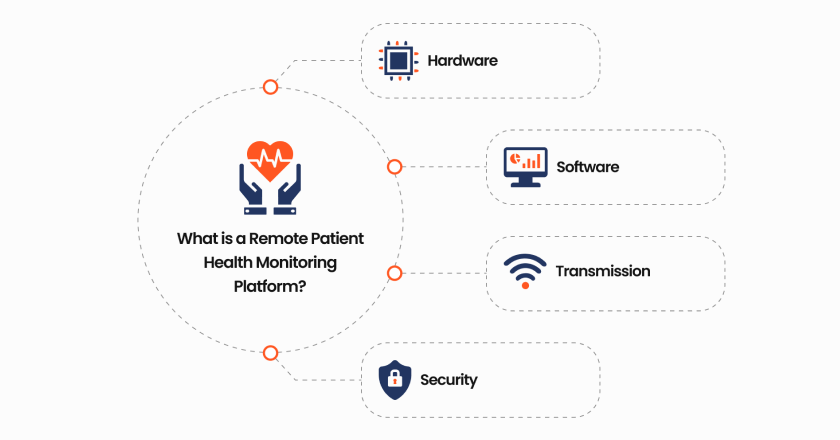User-Friendly Software for Remote Patient Monitoring: Easy Combination and Usage
User-Friendly Software for Remote Patient Monitoring: Easy Combination and Usage
Blog Article
The Future of Medical Care: Remote Patient Checking Simplified
As health care proceeds to progress, one area that holds immense assurance is remote person tracking. With an emphasis on enhancing individual outcomes and enhancing medical care shipment, remote monitoring is poised to change the industry.
Advantages of Remote Person Surveillance
Remote client tracking presents a multitude of benefits for both health care service providers and patients alike. Additionally, remote individual monitoring boosts the total quality of care by offering an extra holistic and comprehensive sight of people' health condition beyond typical in-person check outs.
Moreover, remote client monitoring can bring about enhanced client results and satisfaction. Clients can take pleasure in the ease of getting care in the comfort of their very own homes while still knowing that their wellness is being closely kept track of. This can cause enhanced patient interaction and adherence to therapy strategies, ultimately causing better health and wellness outcomes. Furthermore, remote surveillance can reduce the need for constant health center brows through, decreasing health care prices for both companies and individuals. Generally, the benefits of remote client surveillance are clear, making it a useful device in modern-day medical care shipment.
Innovation Driving Remote Surveillance
In the world of modern-day healthcare, technological developments play a crucial function in driving the evolution and effectiveness of remote patient monitoring. The combination of innovative technologies such as wearable devices, mobile applications, and cloud-based platforms has transformed the way doctor from another location keep an eye on and take care of person wellness - remote patient monitoring platform. These technologies make it possible for continual real-time surveillance of essential indicators, medication adherence, and various other critical health data, permitting timely interventions and customized treatment strategies
One trick innovation driving remote surveillance is the Web of Points (IoT), which allows smooth connectivity in between clinical devices and healthcare systems. IoT devices such as smartwatches and wireless sensors send and gather patient information to central systems, assisting in remote tracking from anywhere in the globe. Expert system (AI) and artificial intelligence formulas further boost remote tracking by analyzing large quantities of patient information to identify patterns, predict health and wellness fads, and sharp doctor to possible issues.
Effect on Health Care Delivery
With the combination of sophisticated innovations driving remote individual monitoring, the effect on medical care distribution is becoming transformative and increasingly profound. Remote patient tracking permits healthcare companies to offer even more positive and personalized treatment to clients, resulting in improved wellness end results and minimized hospital admissions. By from another location tracking important indicators, signs, and medication adherence, healthcare specialists can step in early, avoiding difficulties and boosting the overall quality of care.
Moreover, remote surveillance enhances accessibility to healthcare services, especially for individuals in underserved or rural areas. Clients can obtain continuous monitoring and support from their homes, removing the requirement for frequent in-person check outs. This not only saves time and decreases expenses for both people and health care facilities but likewise decreases the risk of exposure to infectious conditions, a critical factor to consider in the existing healthcare landscape.
Furthermore, remote patient tracking allows doctor to better allocate sources and focus on treatment based on real-time information. By identifying risky individuals and stepping in without delay, healthcare shipment ends up being a lot more efficient and reliable, ultimately leading to an extra lasting and patient-centered health care system.
Improving Individual Results

Furthermore, RPM allows for positive monitoring of chronic problems, reducing the probability of acute worsenings and medical facility readmissions. Clients profit from raised comfort and convenience, as they can get care in their own homes while staying connected to their doctor. This continuous monitoring not just boosts individual fulfillment but also fosters a sense of empowerment and interaction in their very own health and wellness management.
Future Trends in Remote Monitoring
Embracing sophisticated innovations in remote client monitoring is shaping the future landscape of healthcare shipment. One significant trend is the increased use of wearable devices and sensors to accumulate real-time data, enabling healthcare companies to keep an eye on individuals continuously without the need for regular in-person brows through.

Moreover, telehealth systems are becoming extra sophisticated, permitting digital appointments, remote medical diagnosis, and remote person monitoring all in one incorporated system (remote patient monitoring software). This alternative technique to remote tracking is streamlining healthcare visit this site shipment, improving person fulfillment, and ultimately, boosting overall top quality of treatment
Final Thought
To conclude, remote patient tracking provides various advantages in health care distribution, driven by improvements in modern technology. It has the potential to improve person outcomes and change the way health care is supplied. Future patterns in remote tracking will certainly remain to shape the landscape of medical care, offering chances for even more tailored and efficient patient treatment.
Remote patient surveillance presents a wide variety of advantages for both healthcare suppliers and people alike. Additionally, remote client monitoring improves the total quality of care by offering a much more extensive and holistic view of individuals' wellness condition useful source past conventional in-person check outs.
Furthermore, remote patient monitoring can lead to improved individual end results and complete satisfaction. Remote client tracking permits healthcare companies to supply even more positive and individualized treatment to people, leading to boosted health and wellness results and decreased hospital admissions. Remote client surveillance (RPM) plays a significant duty in improving patient results by offering continual, real-time information that allows medical care service providers to interfere without delay and readjust treatment plans as required.
Report this page